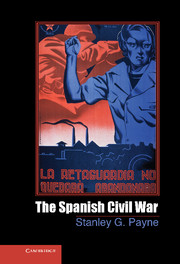Book contents
- Frontmatter
- Contents
- Chronology of Major Events
- Glossary
- Preface
- Introduction Civil War in Twentieth-Century Europe
- 1 Modernization and Conflict in Spain
- 2 From Revolutionary Insurrection to Popular Front
- 3 The Breakdown of Democracy
- 4 The Military Insurrection of the Eighteenth of July
- 5 The Battle of Madrid – the First Turning Point
- 6 Revolution
- 7 Terror
- 8 A War of Religion
- 9 Franco's Counterrevolution
- 10 Foreign Intervention and Nonintervention
- 11 Soviet Policy in Spain, 1936–1939
- 12 The Propaganda and Culture War
- 13 A Second Counterrevolution? The Power Struggle in the Republican Zone
- 14 The Decisive Northern Campaigns of 1937–1938
- 15 The War at Sea and in the Air
- 16 Civil Wars within a Civil War
- 17 The War in Perspective
- Conclusion Costs and Consequences
- Select Bibliography
- Index
- References
9 - Franco's Counterrevolution
Published online by Cambridge University Press: 05 September 2012
- Frontmatter
- Contents
- Chronology of Major Events
- Glossary
- Preface
- Introduction Civil War in Twentieth-Century Europe
- 1 Modernization and Conflict in Spain
- 2 From Revolutionary Insurrection to Popular Front
- 3 The Breakdown of Democracy
- 4 The Military Insurrection of the Eighteenth of July
- 5 The Battle of Madrid – the First Turning Point
- 6 Revolution
- 7 Terror
- 8 A War of Religion
- 9 Franco's Counterrevolution
- 10 Foreign Intervention and Nonintervention
- 11 Soviet Policy in Spain, 1936–1939
- 12 The Propaganda and Culture War
- 13 A Second Counterrevolution? The Power Struggle in the Republican Zone
- 14 The Decisive Northern Campaigns of 1937–1938
- 15 The War at Sea and in the Air
- 16 Civil Wars within a Civil War
- 17 The War in Perspective
- Conclusion Costs and Consequences
- Select Bibliography
- Index
- References
Summary
Francisco Franco has been called the leader of the most successful counterrevolutionary movement of the twentieth century. This is all the more ironic given that Franco clearly had no such ambition as late as July 12, 1936, or even a week afterward, when he arrived in Spanish Morocco to take command of the Army of Africa. Though always a conservative, he had also been discreet and had never been known as a “political general.” Unlike some of his comrades, he had never been directly involved in politics, except for his candidacy on a rightist electoral ticket in May 1936 that was quickly withdrawn. When he finally joined the planned insurrection, Franco had gone along with Mola's scheme to retain the republican form of government, with separation of church and state, and possibly a referendum or new parliament to determine the final character of the regime. Like nearly all the district commanders, Franco began the rebellion under the slogans of “!Viva España! !Viva la República!” The goal, it was claimed, was to restore the legal system, corrupted by the Popular Front.
The Junta de Defensa Nacional, formed by Mola in Burgos on July 23, was an interim all-military junta. General Miguel Cabanellas nominally presided as the most senior active general, ultimately becoming something of an embarrassment insofar as he was a Mason, a moderate liberal, and a former candidate of the Radical Party. The two months that followed became a time of prolonged military emergency, punctuated in the rear guard by mass atrocities in the repression carried out by the Nationalists.
- Type
- Chapter
- Information
- The Spanish Civil War , pp. 119 - 130Publisher: Cambridge University PressPrint publication year: 2012



